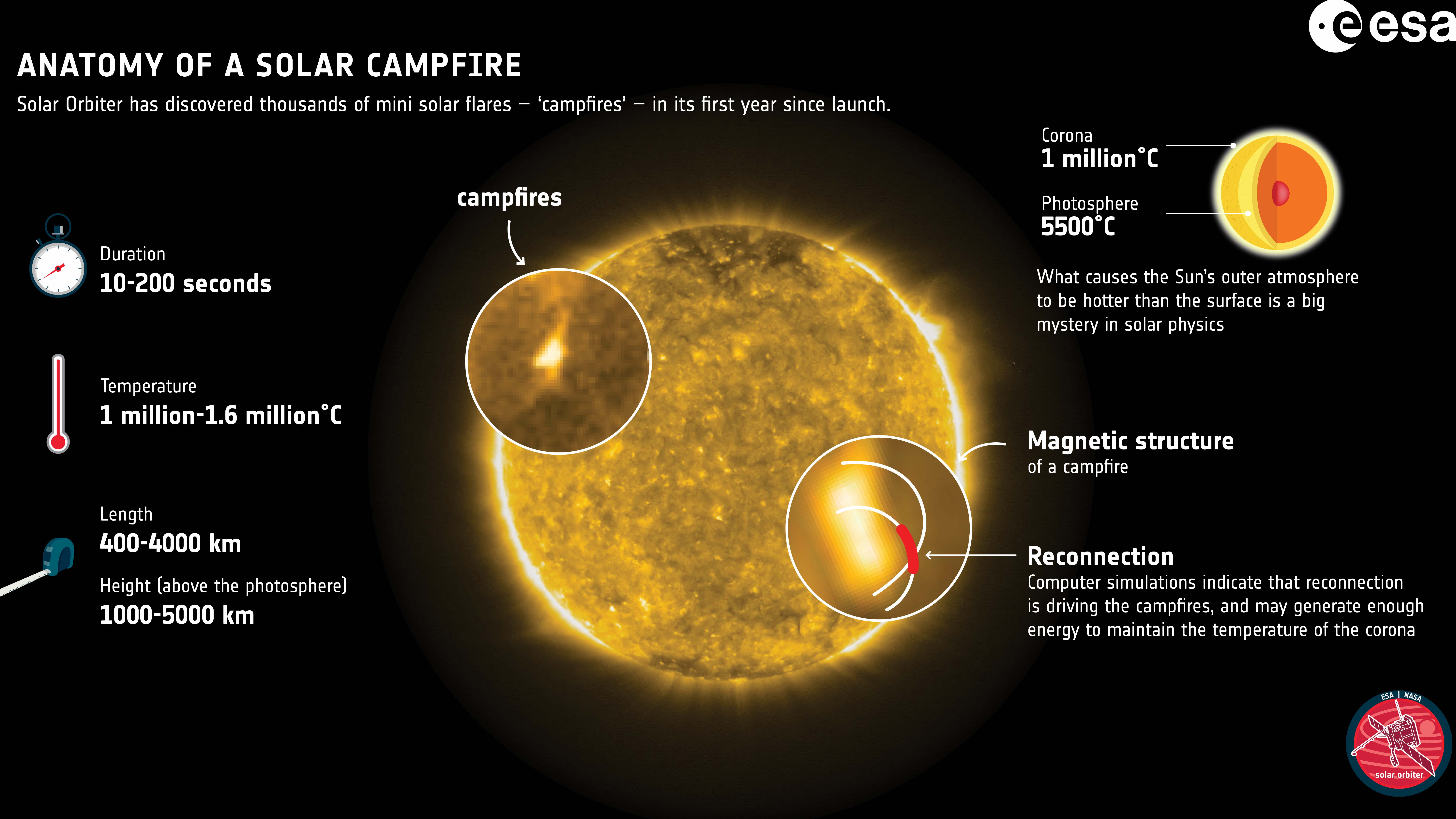Mysterious heating of sun's corona powered by solar 'campfires,' study suggests
One of the sun’s strangest behaviours might be caused by 'campfires' on the star’s surface.

The mysterious heating of the sun’s corona might be powered by miniature solar flares dubbed 'campfires,' discovered by the European-US Solar Orbiter mission last year, a new study suggests.
The temperature of the sun’s outer atmosphere, the corona, has puzzled scientists for decades. Extending millions of kilometers into space, it is unimaginably hot - more than 1.7 million degrees F (1 million degrees C). The solar surface, on the other hand, is a 'pleasant' 9,900 degrees F (5,500 degrees C). The difference defies logic: in most circumstances, material closer to a source of heat is hotter than anything more distant. Scientists have long known some unknown mechanism must be at play.
Now, a new study has found that the heat released by the recently discovered campfire mini solar flares could be enough to sustain the enormous coronal heating. The research was presented at the European Geosciences Union (EGU) General Assembly on Tuesday, April 27, 2021 and accepted for publication in the journal Astronomy and Astrophysics.
The study used computer simulations to model emissions of energy from the sun, hoping to generate flares like those measured in reality by scientific instruments. As the team ran the simulation, they saw brightenings similar in scale to the campfires observed by Solar Orbiter, said Professor Hardi Peter of the Max Planck Institute for Solar System Research in Germany, in a statement released by the European Space Agency (ESA). The scientists then looked more closely at magnetic disturbances around seven of the brightest simulated campfires, which were about the same size as the brightest events detected by Solar Orbiter.
"[The model] traces out the magnetic field lines, allowing us to see the changes of the magnetic field in and around the brightening events over time," Hardi said.
Tracing these magnetic lines revealed that a process called reconnection seems to be taking place, Hardi added. Scientists hypothesize that magnetic reconnections trigger large scale solar flares and coronal mass ejections. The visible disruptions on the sun’s surface occur when two magnetic field lines of opposite direction break and reconnect, releasing a massive amount of energy in the process.
"Our model shows that the energy released from the [campfires] through component reconnection could be enough to maintain the temperature of the solar corona predicted from observations," said Yajie Chen, a PhD student from Peking University of China and lead author of the paper in the ESA statement.
Breaking space news, the latest updates on rocket launches, skywatching events and more!
The campfires, some 250 and 2500 miles (400 to 4000 km) in diameter, might seem large from the human perspective. But they’re actually tiny compared to the better known but rarer solar flares that cause magnetic storms on Earth, as well as beautiful aurora borealis displays.
What gives these campfires significance is their abundance. In the first Solar Orbiter images, released in July 2020, scientists could observe those campfires all over the sun’s disk, each flickering like a candle for ten seconds to a few minutes before disappearing.
The idea that miniature solar flares could be responsible for the mysterious coronal heating was first put forward in the 1980s by U.S. physicist Eugene Parker, the namesake of another ground-breaking solar science spacecraft, NASA’s Parker Solar Probe.
The new study suggests that Parker, now 93 years old, may have been right.
"Our mission is lucky to be building on the incredible ground-work of those that have flown before, and the theories and models already put forward over the last decades," Daniel Müller, ESA’s Solar Orbiter Project Scientist, said in the statement. "We’re looking forward to seeing what missing details Solar Orbiter – and the solar community working with our data – will contribute to solving open questions in this exciting field."
The results are especially impressive since Solar Orbiter is not yet in its official science phase. The spacecraft, which is meant to take the closest ever images of the sun, is still in a period of validation and orbital adjustments known as the cruise phase. It will officially commence its scientific exploration of the star at the center of our solar system in November of 2021.
The images that revealed the campfires were taken in June 2020 around the spacecraft’s first perihelion, the point in its orbit closest to the sun. At that time, the spacecraft was about 48 million miles (77 million kilometres) away from the star’s surface, about half of the average distance between the sun and Earth. But Solar Orbiter controllers continue to tighten its orbit around the sun, which will ultimately bring the spacecraft to the distance of only 42 million kilometers.
During its closest passes, the Parker Solar Probe dives way deeper into the sun’s environment, passing closer than 10 million miles from its surface. But the spacecraft doesn’t carry cameras for imaging the surface of the sun, instead making other measurements of the near-solar environment.
Later in its mission, operators will tilt Solar Orbiter’s orbit around the sun out of the ecliptic plane in which planets orbit, allowing the spacecraft to take the first ever high-res images of the star’s poles. Studying the activity around the poles, the scientists say, will help advance our understanding of the sun’s magnetism and understand what drives the solar cycle, the periodical ebb and flow of the star’s flares and sunpots.
Follow Tereza Pultarova on Twitter @TerezaPultarova. Follow us on Twitter @Spacedotcom and on Facebook.

Tereza is a London-based science and technology journalist, aspiring fiction writer and amateur gymnast. She worked as a reporter at the Engineering and Technology magazine, freelanced for a range of publications including Live Science, Space.com, Professional Engineering, Via Satellite and Space News and served as a maternity cover science editor at the European Space Agency.

